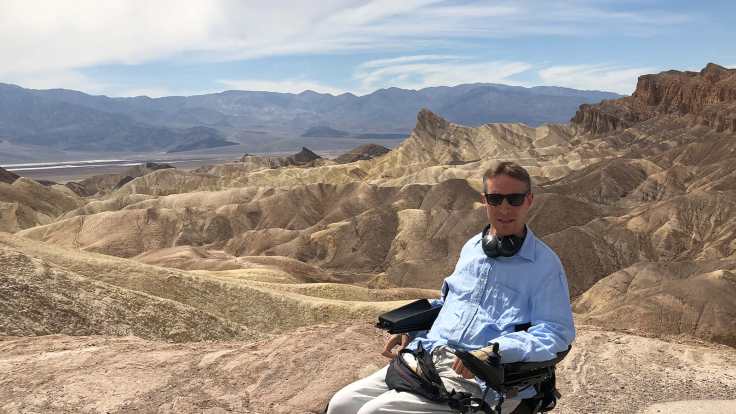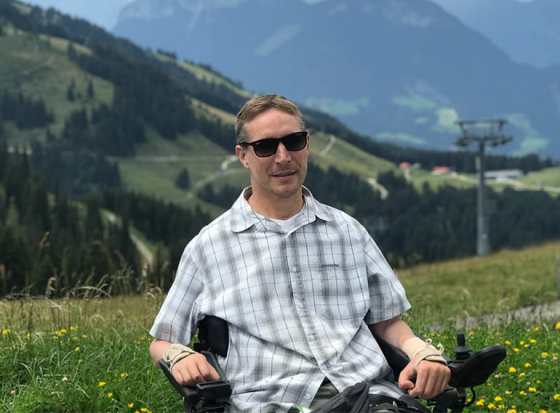By Tim Pemberton
My sabbatical story

What would you do with an extended break from your day-to-day job?
As part of its aim to help people achieve a healthy work-life balance, HSBC offers employees the opportunity to take a sabbatical. Andy Russell, a communications manager for the bank in London, took six months off to see the world – and gained a fresh perspective on his career in the process.
Why did you want to take a sabbatical?
I’d been working for 20 years – many of them at HSBC – and realised I probably had another 20 left in employment. It seemed like a good time to reflect on what life would be like when I retired, without the routine of going to the office every day. I’d always wanted to travel. Knowing I had a job to come back to was the security I needed to take the plunge. I was a bit nervous sending the application for leave, simply because I didn’t want to waste the opportunity.
Where did you go on your travels?
I had a spinal cord injury in a diving accident in my early 20s, and have used a wheelchair ever since. It means some parts of the world are harder for me to travel in, so I stuck to more developed countries. I started with four weeks in the US and Canada, indulging my love of the natural world with the big skies and dramatic landscapes. After that I spent three months in Europe, travelling through seven different countries. There was plenty of time for relaxation and reflection – in the Tuscan countryside and the south of France, for example – and plenty of culture. I even squeezed in a language course in Spain and did a house swap with a woman who lived on a houseboat in Amsterdam. Various friends or family members travelled with me at different stages of the journey.
2018 was the year I did something truly memorable
What were the highlights of your trip?
In Sardinia, Italy, I came across a beautiful beach that was accessible to wheelchairs. I usually have to stay on the promenade because sand is difficult for wheelchairs, but this beach was decked out with slats. There was also a group of volunteers helping wheelchair users go into the water in special buggies. It meant I could feel the sea rather than just look at it from a distance, something I hadn’t done for years. Another highlight was a train journey from San Francisco to New York. Rattling through desert and mountains, and looking up at the stars from my cabin, was a special experience.
Did you face any specific challenges as a wheelchair user?
Unfortunately, the world was not built for people with disabilities. You have to plan ahead to make sure airlines and trains can accommodate you and to find suitable places to stay. Some booking websites have accessibility filters, so you can easily search for accommodation with the features you need, such as roll-in showers or flat-level access. Even with careful planning, however, things can go wrong. I arrived at an apartment in Spain to find the lift was too small, and had a stressful few hours trying to find somewhere else at short notice. But I found it encouraging that many people in the tourism industry were keen to improve. They were open-minded and wanted to know what adjustments they could make in the future.

What impact has the experience had on your working life?
I came back refreshed and with a renewed enthusiasm for my job. The trip also improved my understanding of European culture, which was helpful for my role as Europe is one of the regions I look after. More than anything, it gave me an added appreciation of working for a company that allows you to take these kind of breaks and recognises the importance of mental well-being and a good work-life balance.
What advice would you give to people thinking of taking a sabbatical?
Grab the opportunity. Life moves fast and the years can end up blurring into one. But now I can always say that 2018 was a real marker in the sand for me. It was the year I did something truly memorable.
Sabbatical leave: HSBC’s approach
HSBC employees in most markets around the world can apply for sabbatical leave, provided they have worked at the bank for at least five continuous years and meet certain additional criteria. A typical sabbatical would last between three and six months and includes salary for the first month. How people choose to spend the time is up to them. Some travel, learn a new skill or do voluntary work. Others may want to carry out caring responsibilities or spend time with family. Sabbaticals are one of many flexible working options available to employees at HSBC.
You must be logged in to like or comment on articles